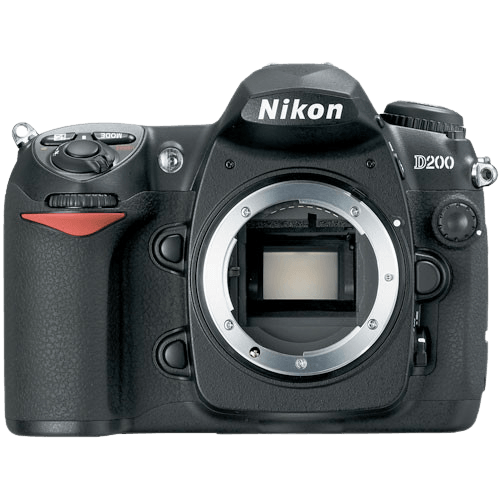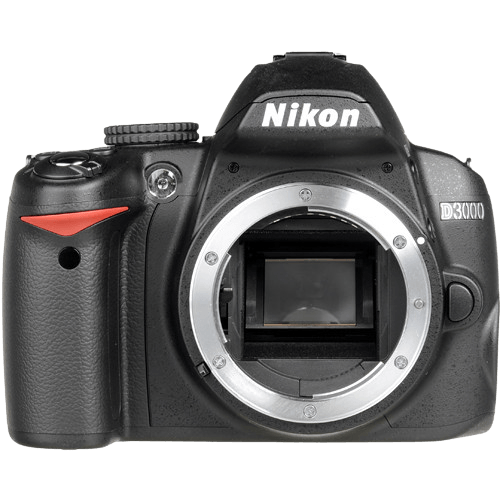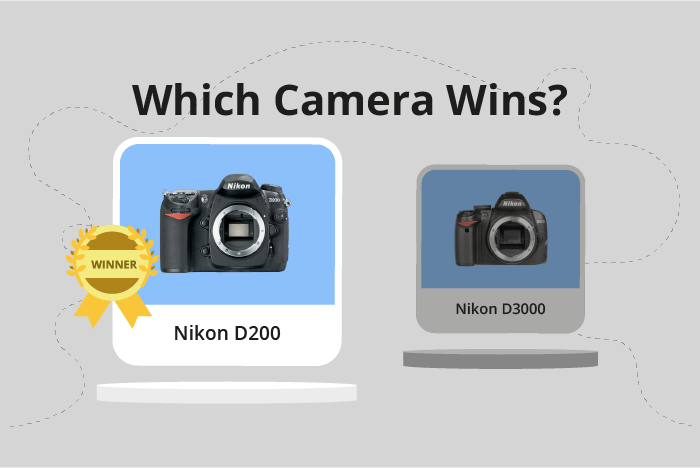Nikon D200 vs D3000 Comparison
Nikon D200

Nikon D3000

The Nikon D200 narrowly edges out the Nikon D3000 with a score of 37/100 compared to the D3000’s 36/100. Both cameras are DSLRs, released in 2005 and 2009 respectively, and have similar features. The D200 is larger and heavier, measuring 147 x 113 x 74mm and weighing 920g, while the D3000 measures 126 x 97 x 64mm and weighs 536g.
The D200’s higher score highlights its better performance, despite being an older model. Its larger size and weight may provide a more solid feel and stability during shooting. On the other hand, the D3000’s lighter weight and smaller size make it more portable and easier to carry around. Additionally, the D3000’s lower launch price of $730, compared to the D200’s $1000, makes it a more budget-friendly option.
Taking these factors into account, the Nikon D200 offers better performance, while the D3000 provides a more affordable and portable option for photographers.
Nikon D200 vs D3000 Overview and Optics
The Nikon D3000 outperforms the Nikon D200 in optics with a score of 43/100 compared to the D200’s 41/100. Both cameras share several specifications, including the CCD sensor type, APS-C sensor size, Nikon F DX lens mount, and the absence of image stabilization.
The D3000 surpasses the D200 with its 12.3-megapixel count, offering higher resolution images than the D200’s 10 megapixels. This allows for more detailed photos and greater flexibility in post-processing, such as cropping or enlarging. Additionally, the D3000 utilizes the Expeed processor, providing improved image quality and processing speed over the Nikon Image processing engine found in the D200.
On the other hand, the D200 holds an advantage in shooting speed, capturing 5 frames per second compared to the D3000’s 3 frames per second. This makes the D200 more suitable for capturing fast-moving subjects or action photography. Furthermore, the D200 has a slightly higher DXOMARK score for the sensor at 64, compared to the D3000’s 62, indicating better overall image quality and performance.
Despite the D200’s edge in shooting speed and sensor performance, the D3000’s higher resolution and advanced processor make it the superior choice in terms of optics. However, the D200 may still be a viable option for those who prioritize action photography or require a slightly better sensor performance. Ultimately, the choice between the two cameras will depend on individual preferences and specific photography needs.
Nikon D200 vs D3000 Video Performance
When comparing the Nikon D200 and Nikon D3000, it is essential to address their video capabilities. In this case, both cameras lack video functionality. The Nikon D200 does not have video capability, and the same applies to the Nikon D3000. It is important to note that a camera’s quality is not determined by its score. Instead, a higher score results from the camera being better in terms of features and performance. In summary, neither the Nikon D200 nor the Nikon D3000 offers video capability, and their scores do not affect their overall quality.
Nikon D200 vs D3000 Features and Benefits
The Nikon D200 wins the features comparison with a score of 30/100, while the Nikon D3000 scores 23/100. Both cameras share several specifications, including screen resolution (230,000 dots), lack of touchscreen, flip screen, GPS, WIFI, and Bluetooth. Despite these similarities, the D200 outperforms the D3000 in a few areas.
The D200 has a larger screen size of 2.5 inches compared to the D3000’s 3 inches. This advantage allows for a more comfortable viewing experience when reviewing images or navigating menus. Additionally, the D200’s higher feature score indicates that it offers more advanced options and capabilities, making it a more versatile camera for various photography situations.
On the other hand, the D3000’s lower score does not necessarily mean it is a worse camera. It may be more suitable for beginners or those on a tighter budget who do not require the advanced features of the D200. Furthermore, the larger screen size of the D3000 might be more appealing to some users, despite the shared screen resolution.
In comparing the Nikon D200 and D3000, it is clear that the D200 has better features, making it more suitable for advanced photographers. However, the D3000 remains a viable option for those who prioritize affordability and simplicity over advanced capabilities. Ultimately, the best choice depends on the individual photographer’s needs and preferences.
Nikon D200 vs D3000 Storage and Battery
The Nikon D200 outperforms the Nikon D3000 in storage and battery with a score of 35/100 compared to 27/100. Both cameras possess one memory card slot, but the D200 accepts Compact Flash (Type I or II) cards while the D3000 uses SD/SDHC cards. Neither camera supports USB charging.
The D200 excels in battery life, offering 800 shots per charge with the EN-EL3e battery, while the D3000 provides 500 shots using the EN-EL9a battery. This significant difference makes the D200 more reliable for extended shooting sessions.
The D3000, however, has no clear advantages in storage and battery compared to the D200. The use of SD/SDHC cards might be more convenient for some users, depending on personal preference.
Taking these points into consideration, the Nikon D200 proves to be superior in terms of storage and battery performance, providing a longer battery life and compatibility with Compact Flash cards.
Nikon D200 vs D3000 – Our Verdict
Are you still undecided about which camera is right for you? Have a look at these popular comparisons that feature the Nikon D200 or the Nikon D3000:

